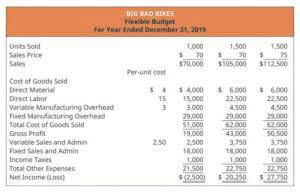Content

The account is debited with the cost of materials, labour and overheads relating to the process and the value of byproducts and scrap is credited. Process Costing The balance of this account, representing the cost of a process, is passed on to the next process and so on until the final product is completed.
Process costing system is a type of costing procedure which is used in accounting for calculating cost in continuous or mass production industries such as food processing, cement, sugar or potato chips. In these industries it is not possible to identity separate units of production because of the continuous nature of production processes involved. Four steps are used to assign product costs to completed units transferred out and units in work-in-process inventory at the end of the period. As with job order costing, you would be encouraged to refer to the operating budget as a reference for your company’s standard direct material, direct labor, and overhead costs. Or, the expected amount for the month in question can be used. ABC Clothing then assigns overhead to each product and the process of allocating overhead is the same as in job costing. After Hannah determines her overhead costs and decides on activity level she allocates those costs for each unit.

So, if they don’t match then you know that you have a mistake somewhere. Next, we’ll breakdown Ending WIP units byDirect Materials, Direct Labor, and Factory Overhead.
What Are The Advantages & Disadvantages Of Process Costing?
Designate costs for complete and incomplete products. https://www.bookstime.com/ can be easier to use than other costing methods, and it can help companies zero in on areas for potential cost cutting. The input will pass through two or more processes before it takes the shape of the output. The output of each process becomes the input for the next process until the final product is obtained, with the last process giving the final product. Production takes place continuously except in cases where the plant and machinery are shut down for maintenance etc.
- A process costing system is used by companies that produce similar or identical units of product in batches employing a consistent process.
- Further, the average cost represents the cost per unit, wherein the total cost is divided by the total number of outputs produced during the period to arrive at the cost per unit.
- Since you’re reading this, you’ll probably have to make the estimate yourself.
- This process makes use of the concept of Equivalent units.
- The organisation can identify such inventory either by physically counting the units or through a software inbuilt in the manufacturing process.
- Eventually, costs have to be allocated to individual units of product.
Cost Control – Being every job is separate and each job has special characteristics and the job is not standardised so cost control is difficult. Completion of task – There is no such requirement. Cost of process can be obtained even if product is incomplete. Controlling aspect – Since production is continuous and products are standardized so comparatively lesser control is required. Controlling aspect – Since each job is separate and distinct, greater supervision and control is required by management. Cost unit – Each Job or batch of product is the cost unit for which cost is ascertained. Cost Calculation – Cost is determined for every job or batch or product.
The cost of direct materials placed into production during the month . Prepare a production cost report for the Milling department for the month of April. Prepare a production cost report for the Mixing department for the month of March. Prepare a production cost report for the Mixing department at Calvin Chemical Company for the month of June. The Molding department requisitioned direct materials totaling $2,000 to be used in production. For each firm listed in the following, identify whether it would use job costing or process costing. Describe the differences between a process costing system and a job costing system.
Similarities Between Job Order Costing And Process Costing
It is applied for various industries like chemicals and drugs, oil refining, food processing, paints and varnish, plastics, soaps, textiles, paper etc. The main benefit of Process Costing is that it provides information that can be used to make critical business decisions. For example, managers using this system can assess profit margin by product and isolate problem products before they become major issues. Process Costing also allows companies to set prices according to production costs. A student’s first thought is that this is easy—just divide the total cost by the number of units produced. However, the presence of work-in-process inventories causes problems.

A method of process costing that includes costs in beginning inventory and current period costs to establish an average cost per unit. Ultimately, job order costing and process costing are cost accounting systems which are both viable – the key is to identify unique circumstances and needs of your business. In this example, just as with the job order costing example, we are assuming that overhead is applied on the basis of direct labor hours. However, if you allocate overhead differently that’s perfectly fine. Because, here, all you’re doing, is taking that total amount of overhead per unit and assigning it to each individual department. Whether you do so based on the number of man-hours each department spends on each item, or some other means, doesn’t matter. Though the overhead allocation process is the same, the types of overhead costs differ from one company to the next.
Business In Action 4 2
This is the total (eventual, once the units are 100% complete) value of the work in progress that the department began the month with. An Equivalent unit is basically how much of work in progress you’ll consider whole, complete units, for the purposes of accounting. For example, if 1,000 units are in WIP and are considered 50% complete, then we would say that the department has 500 Equivalent units. Remember to estimate the percentage complete based off of value, not quantity.

Here, costs are calculated separately for each run. All units completed and transferred out during March are sold by March 31. Products with a cost of $100,000 are completed and transferred from the Packaging department to the finished goods warehouse. Products with a cost of $35,000 are completed and transferred from the Packaging department to the finished goods warehouse. A total of 40,000 units were in beginning WIP inventory. All were completed and transferred out during March.
Composite Or Multiple Costing
The cost per unit can be ascertained at the end of any manufacturing process by dividing the total cost of a process by the number of units produced in that process. Process costing is an alternative method of cost accounting. Like job costing, even process costing is a basic method by which costs are accumulated by processes. In the case of job costing, costs are charged to each individual customer.
Finally, split up the costs by allocating the appropriate amounts to the number of products completed, as well as to the inventory that was considered in-process at the end of the period. Cost of manufacturing such as (direct materials cost + direct wages + direct overhead) per piece. Product costs must be transferred from Finished Goods to Cost of Goods Sold as sales are made. This requires a correct and accurate accounting of product costs per unit, to have a proper matching of product costs against related sales revenue. Companies can calculate costs using several different methods, including weighted average costing, standard costing and first in, first out costing. There are a number of industries in which process costing can be applied.
- Notice that the basic data are at the top of the spreadsheet, and the rest of the report is driven by formulas.
- Abnormal loss cannot be treated like overhead of the process to be shared by good units.
- This enables the company to buy materials in bulk, often leading to volume price discounts from suppliers.
- The point at which they are separated from the main product is called the ‘split off point.’ Till the split-off point all expenses incurred are considered to be joint expenses.
Divide the total cost by the number of units to obtain the cost per unit. The output of a process is transferred to the next process generally at cost to the process. It may also be transferred at market price to enable checking efficiency of operations in comparison to the market conditions.
How Big Companies Manage Their Data?
For example, a computer manufacturing plant will create numerous components that are interchangeable among computers of the same model. Process costing allows manufacturers to sell individual parts separately to computer repair shops or individual buyers, since the manufacturers know the cost of the separate parts. We split the cost between Finished Goods and Work in Progress based on the cost per unit and the respective unit volumes. Main product may not require any further processing. But, by-products may require further processing before they can be sold. All the products are having equal value and importance. Some losses may arise in all the processes due to avoidable and unavoidable reasons.
Output of Previous Process, Input of Next Process – The finished product of one process becomes the raw material for the next process. The output of one process becomes the input to the next process until the finished product is made in the final process. The output from the final process is transferred to the Finished Stock Account. This becomes necessary since each order of an individual customer is different from that of the other. Being different, each order requires different amounts of material, labour and overhead.
Accounting Principles Ii
It is easy to allocate the expenses to processes to have accurate costs. For instance, if the company that manufactures ink cartridges completed 3,000 cartridges and left 2,000 cartridges 50% complete, the company would divide the costs by 4,000.
Because the frames have already been through each department, the additional work is typically minor and often entails simply adding an additional fastener to keep the back of the frame intact. Other times, all the frame needs is additional glue for a corner piece. In other cases, we can have abnormal gains when the actual loss is less than the expected normal loss.
To ensure accuracy, companies need to include only product-related costs from each department involved in the process and correctly allocate cost to work-in-progress at each stage. The cost of the output of the process is transferred to the next process. The cost of each process is thus made up to cost brought forward from the previous process and net cost of material, labour and overhead added in that process after reducing the sales value of scrap. The net cost of the finished process is transferred to the finished goods account.
Calculating Unit Cost Under Process Costing
In process costing, the emphasis is on accumulation of costs for a process during a given period of time and the number of units produced in the process during that period. To determine the unit cost of output of each process, the total production cost of the process is divided by the total quantity of the output of the process during a given period.